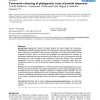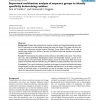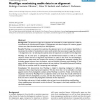24 search results - page 2 / 5 » Stability of multiple alignments and phylogenetic trees: an ... |
BMCBI
2006
13 years 4 months ago
2006
Background: Phylogenetic analyses of protein families are used to define the evolutionary relationships between homologous proteins. The interpretation of protein-sequence phyloge...
BMCBI
2006
13 years 4 months ago
2006
Background: Multiple sequence alignment is the foundation of many important applications in bioinformatics that aim at detecting functionally important regions, predicting protein...
BMCBI
2007
13 years 5 months ago
2007
Background: Proteins that evolve from a common ancestor can change functionality over time, and it is important to be able identify residues that cause this change. In this paper ...
BMCBI
2007
13 years 5 months ago
2007
Background: The presence of gaps in an alignment of nucleotide or protein sequences is often an inconvenience for bioinformatical studies. In phylogenetic and other analyses, for ...
IMSCCS
2006
IEEE
13 years 11 months ago
2006
IEEE
Background: Hydrophobins are fungal proteins that can turn into amphipathic membranes at hydrophilic/hydrophobic interfaces by self-assembly. The assemblages by Class I hydrophobi...



